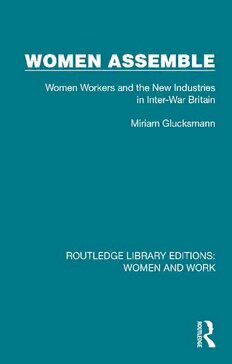
Women Assemble: Women Workers and the New Industries in Inter-War Britain PDF
Preview Women Assemble: Women Workers and the New Industries in Inter-War Britain
ROUTLEDGE LIBRARY EDITIONS: WOMEN AND WORK Volume 6 WOMEN ASSEMBLE WOMEN ASSEMBLE Women Workers and the New Industries in Inter-War Britain MIRIAM GLUCKSMANN First published in 1990 by Routledge This edition first published in 2022 by Routledge 4 Park Square, Milton Park, Abingdon, Oxon OX14 4RN and by Routledge 605 Third Avenue, New York, NY 10158 Routledge is an imprint of the Taylor & Francis Group, an informa business © 1990 Miriam Glucksmann All rights reserved. No part of this book may be reprinted or reproduced or utilised in any form or by any electronic, mechanical, or other means, now known or hereafter invented, including photocopying and recording, or in any information storage or retrieval system, without permission in writing from the publishers. Trademark notice: Product or corporate names may be trademarks or registered trademarks, and are used only for identification and explanation without intent to infringe. British Library Cataloguing in Publication Data A catalogue record for this book is available from the British Library ISBN: 978-1-032-27038-8 (Set) ISBN: 978-1-032-28543-6 (Volume 6) (hbk) ISBN: 978-1-032-28548-1 (Volume 6) (pbk) ISBN: 978-1-003-29734-5 (Volume 6) (ebk) DOI: 10.4324/9781003297345 Publisher’s Note The publisher has gone to great lengths to ensure the quality of this reprint but points out that some imperfections in the original copies may be apparent. Disclaimer The publisher has made every effort to trace copyright holders and would welcome correspondence from those they have been unable to trace. Women assemble Women workers and the new industries in inter-war Britain Miriam Glucksmann London and New York First published 1990 by Routledge 11 New Fetter Lane, London EC4P 4EE Simultaneously published in the USA and Canada by Routledge a division of Routledge, Chapman and Hall, Inc. 29 West 35th Street, New York, NY 10001 © 1990 Miriam Glucksmann Typeset by NWL Editorial Services, Langport, Somerset TA10 9DG Printed and bound in Great Britain by Biddies Ltd, Guildford and King's Lynn All rights reserved. No part of this book may be reprinted or reproduced or utilized in any form or by any electronic, mechanical, or other means, now known or hereafter invented, including photocopying and recording, or in any information storage or retrieval system, without permission in writing from the publishers. British Library Cataloguing in Publication Data Glucksmann, Miriam Women assemble: women workers and the new industries in inter-war Britain 1. Great Britain. Women. Employment. Historical sources I. Title 331.4'0941 Library of Congress Cataloging in Publication Data Glucksmann, Miriam. Women assemble: women workers and the new industries in inter-war Britain / Miriam Glucksmann. p. cm. Includes bibliographical references. 1. Women—Employment—Great Britain—History—20th century. 2. Assembly-line methods—History—20th century. 3. Great Britain—Economic conditions— 1918-1945. I. Title. HD6135.G58 1990 89-70180 331.4'0941'09041-^dc20 CIP ISBN (M15-03196-6 ISBN O-415-03197-4 (pbk) Contents List of tables vii List of figures viii viii Acknowledgements ix List of abbreviations x 1 Introduction 1 Hidden from history 7 Theoretical perspectives 10 A feminist and historical materialist framework 11 Reconstructing the past 23 2 The changing pattern of women's employment 29 Three profiles 29 Women's waged work 37 Changing areas of women's work 46 Women in the electrical engineering and food processing industries 57 3 The restructuring of industrial capitalism 67 Decline of nineteenth-century heavy industry 67 The emergence of new industries 72 4 Five factories 93 Peek Frean 95 Electrical and Musical Instruments Limited 111 /. Lyons and Co. Ltd 123 Morphy Richards 131 Hoover 137 Contents 5 Women assembling: work, wages and assembly- line production 143 The assembly-line production process 147 Technical division of labour and skill structure 154 Relations of production of assembly-line workers 158 6 Women assembled: gender and the division of labour 197 Relationship between technical and sexual divisions of labour 197 Material basis of segregation 209 Ideological construction of women's work: sex-typing and the marriage bar 216 7 Homeward bound: changes in domestic production and consumption 226 Circuits of domestic production and consumption 226 Domestic labour 228 'Ideal' home and 'ideal* housewife 236 Domestic service 244 8 Women and the total social organization of labour 257 Class relations of women assembly workers 259 Organization of total social labour 265 Theoretical resonances 269 Future directions 279 Appendix: List of main people interviewed 283 Notes 285 References 304 Index 319 Tables 1 Number of women aged 16 to 64 in insured employment, 1923, 1929, and 1932-8 40 2 Age-specific participation rates of women, England and Wales, 1911 to 1951 41 3 Proportion of women occupied by region, 1931 44 4 Growth in number of insured persons, male and female, by region, 1923-38 45 5a Changes in numbers of women employed in selected industries, England and Wales, 1921 and 1931 47 5b Changes in numbers of women employed in selected industries, England and Wales, 1931 and 1951 47 6 Number of insured employees in selected industries. Women aged 16 to 64 at each mid-year, United Kingdom 48-9 7a Principal occupations of women in 1921 and 1931 52 7b Principal occupations of women in 1931 and 1951 53 8 Proportion of women occupied at each age period in selected occupations, 1931 56 9 Women and men employed in electrical installations, cables and apparatus (Census Industry Order VI5), 1921 and 1931 59 10 Average numbers employed in electrical engineering, 1930 and 1935, by age and sex 60 11 Number of insured persons engaged in electric cables, wire, and electric lamps in Greater London, July 1923 and 1930, classified by sex and age 60 12 Age of operatives in electrical manufacture, 1931, by sex 61 13 Operatives in the food trade, 1930 and 1935, by sex and age 64 vn
